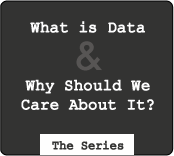 Matthew Hurst, from Microsoft Live Labs and the co-creator of BlogPulse, answers my question – “What is data and why should we care about it?”
Matthew Hurst, from Microsoft Live Labs and the co-creator of BlogPulse, answers my question – “What is data and why should we care about it?”
In writing this brief article, I tried to answer the following: what attracts me to data?
An Abundant Resource
Data is everywhere – from the streams of posts in the blogosphere to stock trading graphics spilling from news media to science projects in kindergarten. It permeates our modern world, and yet few of us are equipped to interpret it critically. More importantly, few of us are protected against the misuse and manipulation of the truth via data. Users of databases (who include the millions of users of search engines) are slowly but surely becoming exposed to more sophisticated views of data and thus the average data literacy will, hopefully increase.
Working in the field of data mining is very exciting at this time as it has the potential to truly impact the perception and understanding of the world-as-data. Sites like Swivel and Many Eyes are in some sense at the cutting edge of this progression, with major public databases (like search engines) nervously following their lead.
A fundamental challenge in empowering users with data is the legacy of impoverished tools. Currently, one is required to make many low level interactions in order to synthesize a result required for a task. Consequently, the tools and infrastructure around data interactions have moved towards high volume, immediate response paradigms. However, the added value, increased accuracy and relevance of more sophisticated processes, and the additional investment required on the part of the user to learn how to consume and manipulate enhanced data displays comes with a cost. To make the jump, users will have to be convinced of the value of enhanced interactions and displays, spend a little more time working with the data and so on.
A Vector of Truth
Data, if collected and analysed correctly, can support or refute our intuitions and beliefs. In addition, the anlaysis of data can hint at some very human structures such as those found in language and in the ways in which we conceptualize the world. Data may be used to help us understand our environment. By working with data, we can grasp better models of ourselves and our world.
Beauty in Exploration
Visualization is an essential tool for understanding data and drawing inferences from it. The last ten years of advances in computer performance and graphical displays have opened up the possibilities for displaying data in rich and dynamic ways. This has lead practitioners down a dangerous path balanced between aesthetics – the visual impact and design of data display, and utility – the capability of a visualization to intuitively and efficiently assist the user. That being said, the aesthetics of data visualization can play a huge part in attracting users to the topic being visually described, to encourage them to ask ‘it’s pretty, but what is it?’ Hopefully the answers to that question will lead to better understanding on all fronts.

 Visualize This: The FlowingData Guide to Design, Visualization, and Statistics (2nd Edition)
Visualize This: The FlowingData Guide to Design, Visualization, and Statistics (2nd Edition)
